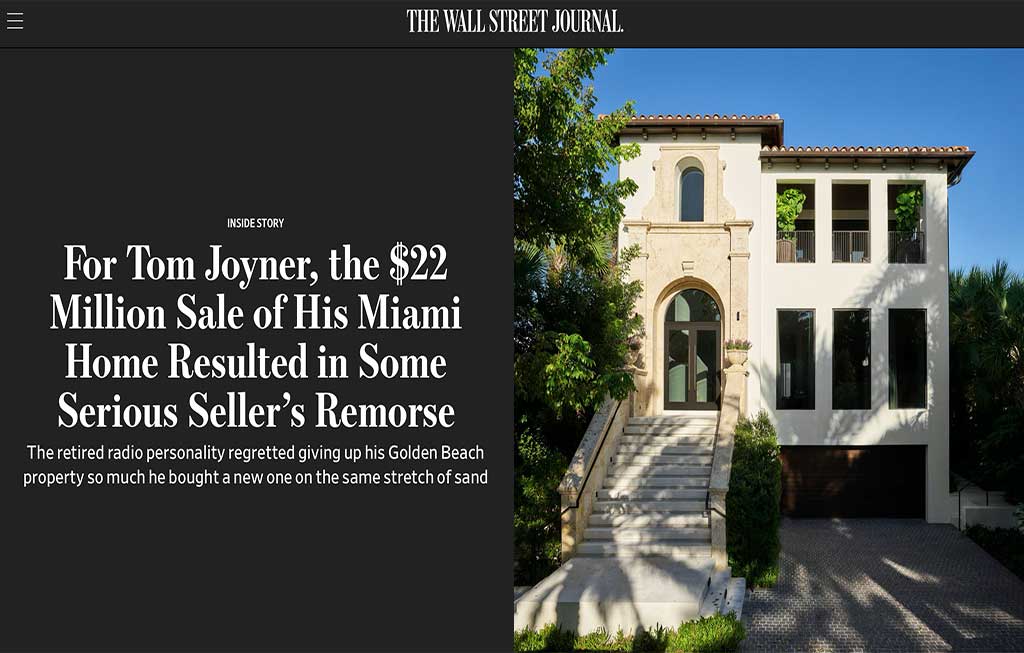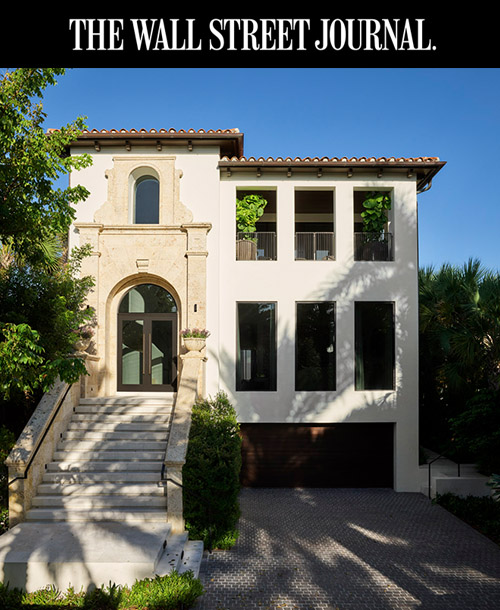
WRITTEN BY NANCY KEATES / PHOTOGRAPHY BY DOUGLAS FRIEDMAN, KRIS TAMBURELLO AND NICK GARCIA
In 2015, Tom Joyner was living in what he describes as paradise: a 9,800-square-foot, white house decorated with bright colors on Miami’s Golden Beach. Then, one day, a man knocked on his door and offered him $22 million for the property—twice what he had paid for it a decade earlier.
“I said here are the keys,” says Mr. Joyner, 71, a nationally syndicated radio host who retired last year.
He loved the house. He didn’t want to get rid of it. But he couldn’t turn that offer down. After a few days of regret, and a call to his lawyer to try to get out of the deal, Mr. Joyner’s real-estate agent found him another house on the same beach. It wasn’t for sale, but Mr. Joyner’s bid of $10.5 million—about $2 million more than the house had sold for a year earlier—was accepted.
Mr. Joyner then embarked on a $7.5 million, five-year renovation, turning what was a dated, five-bedroom Mediterranean with lots of small rooms, arches, columns and marble, into a three-bedroom, open space with large windows and lots of skylights.
His first design goal was to be able to see the ocean from every room. Watching the moon rise and the sun set on the water is a source of his creativity, he says. But it also meant he had lots of new ideas, which led him to constantly change his mind about the project. “I’m a DJ. I’m always fixing stuff in the mix,” he says.
He also decided he wanted this house to be more sophisticated and modern than his previous homes in Dallas, Beverly Hills and New York, which had walls painted in red and turquoise and lots of accessories such as pillows and candles. To get that aesthetic, he hired designer Deborah Wecselman of Miami-based Wecselman Design, former senior director for Ralph Lauren’s international store design.
“We were both set on a color palette,” says Ms. Wecselman, who argued for beige and other neutral, earthy colors. She used fabrics to upholster contemporary furniture from designers Christian Liaigre and Holly Hunt. She said this allowed for a sophisticated but comfortable effect, one she likens to Mr. Joyner’s persona. She carefully curated his bright and lively artwork.
Mr. Joyner sneaked in bright elements. He insisted on fire engine red linoleum flooring for the basement, which holds a boxing ring and gym, and in the master bathroom installed a bright red urinal in the shape of The Rolling Stones lips logo.
A symbol of the compromise that ensued between them is the open closet in the third-floor bedroom suite. Made of dark wood, with simple lines, it displays Mr. Joyner’s shirts like a rainbow, starting with fire engine red and moving through orange, yellow, green, blue, purple pink and brown. Below the shirts are his variegated sneakers, many custom-made.
Mr. Joyner credits his sense of style to growing up in Tuskegee, Ala., where his parents met while working at the air base and later built a Midcentury Modern house with a large picture window. He remembers performances in town by musicians such as Ella Fitzgerald and Count Basie. “Style was in my neighborhood.”
After graduating from Tuskegee Institute (now Tuskegee University), Mr. Joyner started in radio in Montgomery, Ala., and in 1994 went on to become host of “The Tom Joyner Morning Show,” an ABC Radio Networks nationally syndicated show aimed at Black listeners, which drew approximately eight million listeners every week in 120 markets and featured interviews with presidents (Clinton and Obama), celebrity actors, musicians and renowned Black academics.
While living in Dallas in the late 1990s, Mr. Joyner began vacationing in Miami. He bought his first house on Golden Beach as a Valentine’s Day and anniversary present for his wife; they have since divorced.
Mr. Joyner calls his new house his bachelor pad, in part because his bedroom takes up the entire third floor. Since the pandemic, and a stroke he suffered last spring, Mr. Joyner hasn’t left very often. That is fine with him. His backyard is a beach and he treasures the beauty of his surroundings.
Even though he loves his new home, Mr. Joyner says having someone knock on your door once and offer you twice what you paid makes it hard not to wonder if that would happen again. He says if that happened, he would be tempted to sell, since he liked the renovation process enough to go through it again with a new house. Plus, he notes, “there are more houses on the beach.”

